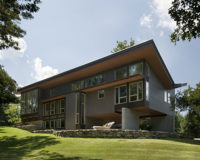When it comes to giving your architect direction, you can tell him about yourself, your family, and your aesthetic and programmatic needs for a house. Alternately, you can take him with you to your homeland, have him stay in your family’s home, and let him figure it out from there. The latter is what Felicio Franco did with architect David Stern, AIA, of the Boston-based firm Stern McCafferty Architecture and Interiors. Stern recalls his client asking if he and his wife and partner in the firm, Diane McCafferty, had ever been to Portugal. When he replied no, “he asked if we wanted to go with him that next weekend,” says Stern. “It was a very different way of building a working relationship, but Felicio is a very different kind of guy.”
Sao Miguel, one of Portugal’s Azores Islands, is noted for its stunning scenery and picturesque villages (“as if Switzerland and Hawaii had a child,” says www.azores.com), and there’s a certain quality of light that lends a magical dimension to everyday life. The white stucco dwellings are simplistic in form, and use lots of tile and wood. But Franco, a hairdresser who owns two salons, didn’t invite Stern to stay with his family so that he could recreate a home from that region. That said, a certain translation of the character of Franco and his wife Martha’s childhood experience with residential architecture was in order. Also part of the design program, the couple’s daughter and her baby would be sharing the home, so a suite of rooms that functioned somewhat independently from the rest of the house would be needed.
The result is a three-bedroom 3,500-square-foot house that sits on a three-acre site overlooking Clark’s Cove and Vineyard Sound in South Dartmouth, Massachusetts. While the idiosyncratic form of the home seems perfectly placed on the site, Stern reveals that because of a complex grid of site restraints—wetland setbacks, flood-plane restrictions, utility easements, view corridor limitations, and zoning restraints—there was a narrow topographic opportunity for placement. “I’m a hairdresser, and I know that the right answer is not always what people think they want for their hair,” says Franco. “It’s the same for this house. David told us how the house could fit on the property, and it feels like where he was able to place it was exactly where it always belonged.” Like the perfect haircut you didn’t know you wanted, the home stands out from its surrounding, more traditional, neighbors, yet fits its site quite naturally.
Essentially two volumes—one facing northwest that is rectilinear and contains the entry facade, the other facing southeast that is open and transparent—the home was designed with the main living areas and master suite on the second floor to capture views and light. The lower floor, more private and with less glass and opacity, houses the suite for Franco’s daughter and grandchild.
The interior palette is simple and uncluttered, with aluminum, glass, bleached wood, and plaster as the principal materials, as well as mahogany for the master suite’s deck. Light takes center stage as an important element as well. “When you’re designing with a minimal palette, three materials instead of 30, light has an opportunity to be one of the elements that you can really see,” says Stern. “That’s apparent in this house.” What’s not apparent in this house is a lot of clutter, and not because it’s hidden away in storage areas. “The Franco’s simply don’t have stuff to store,” notes Stern, who says that when he visited his clients at their previous home he thought the lack of “stuff” there meant the house was already on the market. It wasn’t. The Francos simply aren’t collectors. “The home we designed for the Francos doesn’t have a basement, doesn’t have an attic, and just didn’t require storage areas, except for big closets for clothes,” he says. “It’s pretty cool. They just have nothing to store.” Franco verifies Stern’s observation about this unusual situation. “I grew up in a typical Portuguese house,” he says. “My mother had stuff everywhere, and plastic covers on the sofas. I wanted to get away from that. We have no bling, nothing, no clutter.”
Without stuff, and now without his daughter and granddaughter in the house (“she had it great here, but she went and got married and had another baby and moved out,” he laughs), Franco and his wife pronounce that their house is exactly what a home should be: a refuge and a place to physically and emotionally refuel each day. “I work 14- or 15-hour days, and coming home to this house feels like I’m on vacation all the time.”


